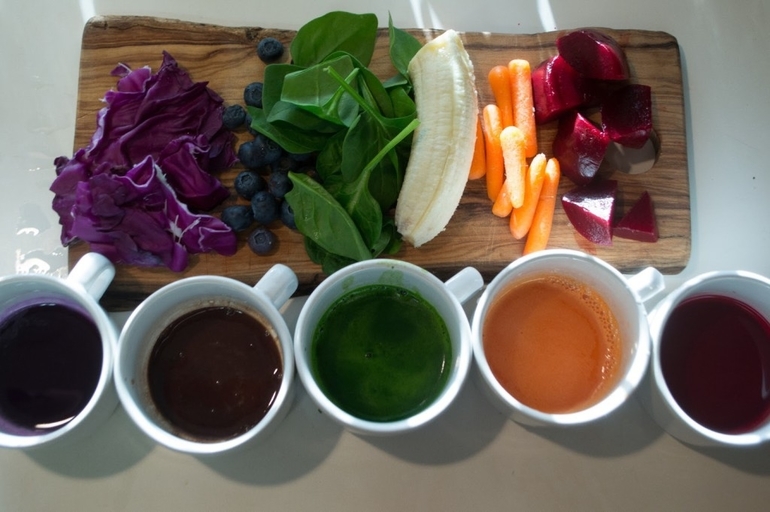Using natural materials to create works of art dating back to the Stone Age, when prehistoric people used organic and inorganic pigments for applying markings on the wall caves. In today's world reappear stunning paintings created from natural materials. Art of using the gifts of nature involves their creative use to create an original art object.

Content
- Artists using natural materials
- Natural paints with his own hands
- controversial art
Artists using natural materials
There are more contemporary artists who use natural, sometimes unconventional materials in his work.
Some of the artists have become popular all over the world:


- Andy Goldsworthy - an artist who uses natural materials such as leaves and stones, to create sculptures and drawings that reflect the relationship between materials and their environment. His work often takes a lot of time and effort, but it usually is not designed for a long time. After completion of its operation are photographed and then gradually exposed to weather and time factors.
- Paintings created from natural materials, made famous by Brigitte Beth Collins (Flora Furazher). Her charming botanical creations from fresh plants and flowers conquered the world. The ephemeral nature of her art requires it to quickly create his work and had time to take a picture of it before the flowers fade.
- Original paintings by Vietnamese artists do. For example, Dinh Thong uses in his work the usual chicken feathers, and Bui Cong Hien creates masterpieces of butterfly wings. Popular artists and eastern rice pattern, the formation of which requires accuracy and precision of movements.
But not only do pictures of the gifts of nature. For example, the Montreal artist Raku Inoue, inspired by the art of ikebana, hand makes the bugs, using materials from his garden. He modestly calls the process of creating their thumbnail "light morning exercise for the mind," but it bugs - they are real works of art.
Natural paints with his own hands
Many people are familiar with from childhood crafts from natural materials. In kindergartens and schools often use acorns, flowers, leaves, pine cones, stones, shells, twigs, and many other natural items for creativity.
But there are more original and interesting way to make a life-crafts - painting with natural dyes. This is a great lesson, the children will be very curious to first extract the paint, and then use it for drawing. Creative need:


- The easiest and most obvious material for paint - berries. You can use cherries, raspberries, strawberries or blackberries.
- To make the paint is green, need a bit of spinach. When using ground ginger and turmeric can make a palette of colors from yellow to dark brown.
- To create a paint also need a little bit of flour to mix it with juice, and a colander for straining.
- For most paint brushes require any paper watercolors.
Before grinding and collecting the juice you need to stock up on the apron for all participants, paper towels and plenty of bowls. Products that will be used, must be placed in a bowl and mash them with a fork, and then passed through a colander or sieve. For the production of some pigments products must be pre-cook, but the berry colors that do not require.
Before creating a paint green spinach need scalded with boiling water or put them in a bowl with a microwave oven, add a little water. To create a beautiful rich yellow color, it is better to use turmeric, ginger is paler. If you mix with turmeric various berry juices, you can get a whole range of colors.
After separation of juice is necessary to add a small amount of flour into each new colors to slightly thicken them. If the paint is too thick, you can add water. Natural palette is ready, you can begin to draw!
controversial art
Art can not only please the eye, but also boldly challenge the well-established in the community point of view or opinions. For example, the heated debates cause work with organisms that were once alive. This practice raises ethical questions about what is right or wrong in terms of the treatment of dead organisms. For example, it is generally accepted that the autopsies and taxidermy can be useful for science and scientific progress. But can it be art?

Damien Hirst - British artist who explores the theme of death in his work. His most famous works include a series of dead animals (shark, sheep and cow), stored in formaldehyde.
Gunther von Hagens - German anatomist who creates and shows the embalmed human body and parts thereof. Although he sees himself more scientists and medical professional, not an artist, many people consider it an art exhibition.
The act of displaying dead animals for aesthetic purposes or demonstration of a deceased person's body for educational purposes causes a wide range of reactions. In fact, from the point of view of science, all life on earth - is also nature, but whether it is necessary to use such a "material" in the arts?
Either way, the creation of works of art from natural materials It allows you to rethink the value of natural elements. This work combines nature with an artistic vision of the creator, raises questions of ecology and says about the relationship of humanity to the world.



